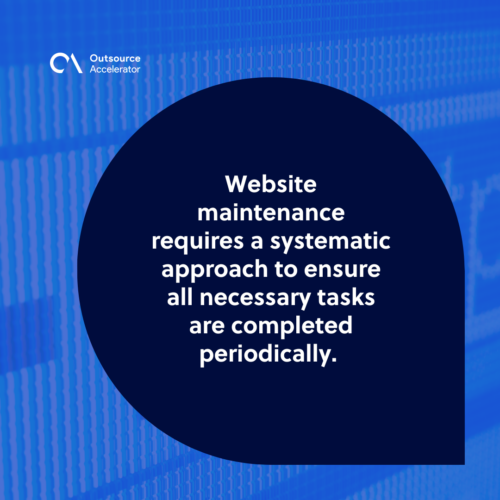Why do you need website maintenance services?

Any business owner nowadays would agree that a website is a crucial aspect of your online presence. It is the first point of contact for potential customers and serves as a representation of your brand.
However, it’s not enough to just have a website. It’s equally important to maintain and update it regularly to ensure that it is functioning optimally. Maintaining a website goes beyond its initial design and launch.
In this article, we’ll discuss the importance of website maintenance, the steps involved, and the types of website maintenance services available.
What is website maintenance?
Website maintenance encompasses a range of tasks performed regularly to keep a website fully functional and up to date. Simply put, it involves the regular upkeep and monitoring of a website to ensure it’s working perfectly.
Website maintenance services are essential to ensure your website is secure, performs well, and provides an optimal user experience (UX).

Importance of website maintenance services
There are several reasons why website maintenance services are important for organizations.
Here are some of the key benefits:
Improved website security
A secure website protects your business and your customers from cyber threats such as hacking, malware, and viruses.
Regular website maintenance services such as software updates and security monitoring and protection can help to prevent security breaches. They ensure that your website is safe and secure.
Better website performance
Website performance is a key factor in providing a positive UX. Users can become frustrated and leave if they encounter a slow or unresponsive website.
Website maintenance services optimize your domain’s speed, code, and databases and address performance bottlenecks. This leads to faster loading times, improved navigation, and enhanced user satisfaction.
Enhanced user experience
A positive user experience is critical to the success of your website. A well-maintained site provides a seamless browsing experience for visitors.
By regularly updating content, fixing broken links, and optimizing navigation and the user interface (UI), visitors can find what they need easily.
This contributes to higher user satisfaction, encourages repeat visits, increases engagement, improves conversion rates, and ultimately enhances revenue.
Improved search engine rankings
Website maintenance improves search engine optimization (SEO), which is an important aspect of having an online presence.
Related website maintenance services for SEO improvement include content updates, keyword optimization, and monitoring SEO performance.
These services help boost your search engine rankings, increasing visibility and organic traffic.
Reduced downtime and increased uptime
Website downtime can be costly for companies because there’s the possibility of lost business opportunities and user frustration.
Ultimately, website downtime can lead to revenue loss and decreased productivity, negatively impacting your brand reputation.
Regular website maintenance services help identify and resolve issues promptly, minimizing downtime and maximizing website uptime. They ensure that your web page is available and accessible to visitors whenever they need it.
Elevates corporate image
A well-maintained website reflects positively on your brand’s image and professionalism. It instills trust and confidence in your audience, making them more likely to engage with your products or services.
It also shows that you are committed to providing a positive UX and that you take your online presence seriously. Conversely, a poorly maintained site can harm your reputation and credibility.
Conducting website maintenance services steadily can help to build trust with potential customers and improve your brand reputation.

13 types of website maintenance services
Website maintenance services encompass a wide range of tasks to keep your domain functioning optimally.
Here are some of the common types of website maintenance services:
1. Regular software updates
Regular software updates are essential to ensure that your website is running the latest version of the software. This includes updates to your content management system (CMS), plugins, and themes.
Software updates can help modify website security and compatibility, fix bugs, and improve website performance.
2. Enhancing website speed
A slow website can frustrate users and lead to decreased engagement. Optimizing its speed involves various techniques such as caching, image compression, minifying code, and reducing server response time.
These measures enhance UX and improve search engine rankings.
3. Website backups
Website backups are essential to ensure that your web page can be restored in the event of a security breach, hardware failure, website crash, and other emergencies.
Carrying out regular backups can help reduce downtime and ensure your site is up and running quickly.
4. Fixing HTML errors
Regularly reviewing and fixing HTML errors, such as broken tags or invalid code, ensures your pages display correctly across different browsers and devices.
Fixing any HTML errors not only enhances website performance and UX but also helps with SEO.
5. Security monitoring and protection
A website can be protected from cyber threats by implementing security measures such as intrusion detection systems, SSL certificates, and firewalls.
Constant monitoring and security audits identify vulnerabilities and mitigate potential risks and ensure that your website is safe and secure.
6. Content updates
Keeping your website’s content fresh and relevant is crucial for engaging visitors and improving search engine rankings. Routine content updates ensure your web page is up-to-date and relevant.
This includes updating product descriptions, adding new blog posts, updating images, and incorporating user feedback.
7. SEO monitoring
SEO monitoring helps optimize your website for search engines. Frequent SEO monitoring can help determine areas for improvement and make sure your domain is ranking well in search engine results pages (SERPs).
Keyword research, optimizing meta tags, improving site structure, and tracking search engine rankings are some of the tasks involved in SEO monitoring.
8. Performance optimization
Performance optimization enables your website to work properly. This maintenance service involves:
- Monitoring website speed
- Addressing performance bottlenecks
- Optimizing database queries
- Improving server response time
- Website caching
- Image optimization
- Code optimization
Performance optimization boosts UX and reduces bounce rates.
9. Responsive design maintenance
Nowadays, more and more people are accessing online pages through mobile devices. Responsive design maintenance optimizes a website for different screen sizes and devices.
This type of website maintenance service includes accessibility testing. It helps you determine whether your domain can be easily accessed by people with disabilities (PWDs) and users with slow internet connections.
Note that a well-maintained and well-designed website ensures that it is displayed correctly and offers a seamless experience across different devices.
10. Fixing broken links
Broken links can negatively affect a website’s performance, visitor experience, and SEO. Continuous implementation of website maintenance services can help identify and fix broken links, allow for smoother navigation, and preserve SEO efforts.
11. Reviewing website analytics
Analyzing website analytics provides insights into user behavior, traffic sources, and engagement metrics. Periodic reviews of website analytics can pinpoint areas for improvement and refine your online strategy.
12. User management
Managing user accounts, permissions, and access levels ensures the security and integrity of your website’s backend.
Regular user management can help maintain control, prevent unauthorized access, and ensure visitors have the appropriate permissions to access your site.
13. Support and maintenance plans
The best way to ensure your website is well-maintained and up-to-date is to acquire support plans that provide website maintenance services.
There are plenty of providers that include most of the services mentioned, as well as other important solutions such as web hosting, SSL certification, and email support.

Website maintenance services checklists
Website maintenance requires a systematic approach to ensure all necessary tasks are completed periodically.
Keeping a website running smoothly takes a lot of effort, especially with time-sensitive tasks like security updates and patches.
With that being the case, here are the checklists of website maintenance services you should do regularly:
Weekly checklist
It’s good to conduct regular website maintenance every week to check on day-to-day functionality and verify the site is performing properly.
- Ensure all pages load error-free
- Perform a backup and securely store previous site versions
- Update website software and plugins
- Verify the functionality of all forms on your website
- Delete any spam comments from posts and pages
- Scan pages for broken links
- Identify and address 404 errors by fixing or redirecting
- Craft engaging blog posts to foster community interaction and boost SEO traffic
Monthly checklist
You can begin to analyze user engagement and find areas of improvement when you carry out monthly website maintenance.
- Evaluate the website’s load speed and ensure optimal performance
- Conduct a thorough security scan to identify any anomalies
- Examine website analytics from the previous month
- Review the blog for potential article updates
Quarterly checklist
Doing a quarterly website review allows you to look at things involved in the bigger picture.
- Assess your website design and structure for potential enhancements
- Evaluate graphics and images for possible updates
- Review SEO elements for maximum effectiveness
- Test and fine-tune popups, forms, and calls to action
- Analyze your workload for automation opportunities to improve efficiency
- Conduct comprehensive cross-device and cross-browser testing to ensure proper display
- Evaluate advertising and marketing campaigns for necessary adjustments or updates
- Verify backup integrity by restoring a previous version of the website
Annual checklist
Annual website maintenance services are important because it lets your website’s design and purpose align with your long-term goals.
- Ensure that references to the current year are up to date
- Thoroughly review each page to ensure content accuracy, proper grammar, typo-free text, and relevance
- Assess active email addresses and eliminate any unnecessary ones
- Verify the renewal status of your website domain name
- Evaluate whether a website design update is warranted
- Review all high-performing blog articles and determine if they can be refreshed with new content

Website maintenance services are crucial for the long-term success of any website. You can proactively maintain your online presence by understanding the importance of website maintenance, the different types of services available, and the steps involved.
Remember, acquiring website maintenance services serves as an investment for the growth and success of your online business and personal brand.







 Independent
Independent




